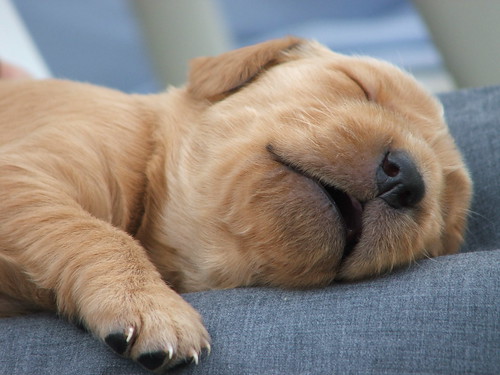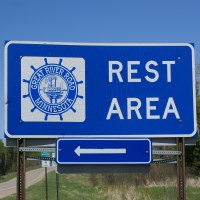So let's get some facts about naps.
- Most mammals sleep on and off throughout the day. This is called polyphasic sleeping. Dogs, for example, are polyphasic sleepers.

Dogs are excellent nappers. This puppy is sacked out.
(Photo from The Dog Napper)
- Though we are mammals too, people generally sleep at night and are awake during the day. But researchers aren't sure whether this is our natural sleep tendency or if we, too, would be polyphasic sleepers.
- Some sleep researchers say that we still have naptimes programmed into us, and that we tend to get extremely sleepy from 2-4 a.m. and again between 1 and 3 p.m. I'd agree with that 1-3 p.m. sleepy time, for sure.
- These researchers say that the afternoon sleepy time doesn't have anything to do with when or what or how much we ate at lunch, but that this is an "afternoon quiescent phase" that's part of how our bodies function.
- But if we do get sleepy in the afternoons, how come we don't all take naps? Newborns, young children, and the elderly take naps all the time. Why not the rest of us?
- Studies have shown that naps improve alertness, creativity, mood, and productivity, they help reduce stress, they may lower the risk of stroke and diabetes, and they help curb excessive weight gain. So I ask again, why don't we all take naps?
- Some researchers say that the only people who like naps are those who are getting enough nighttime sleep to begin with. If you're getting enough sleep, you won't need a nap, and if you tried to take a nap, it wouldn't work or you wouldn't feel refreshed afterward. In other words, it's the nap-lovers' fault. According to these researchers.

Leonardo daVinci (pictured here), Winston Churchill, Napoleon Bonaparte, Albert Einstein, and John F. Kennedy were all regular nappers. Were these people somehow lazy or unhealthy or bad sleepers? Or were they actually smart enough to reap the benefits of napping?
(Photo from Lifting the Veil on Leonardo)
- Other sleep researchers say that it's a subtler question of physiology, nothing to do with how much nighttime sleep you get or don't get.
- According to this latter theory, there are simply some people -- like me -- who thrive after naps. They wake feeling refreshed and rejuvenated, with increased alertness and performance.
- Other people, however, don't have good luck with naps. They may have trouble falling asleep during the daytime. Or if they do manage to nap, they wake up feeling groggy and disoriented. That grogginess and sluggishness is so thick they pretty much can't function for at least a half hour afterward. This groggy post-nap state is called "sleep inertia."
- It may help to splash cool water on your face or walk around a bit to try to get the sleep inertia to lift. Some people say those tips help, but others say it doesn't matter what they do, they can't shift that grogginess. They just have to wait for it to go away.
- If you're one of the people regularly afflicted with the sleep inertia, it looks like there's not a whole lot you can do to change that. You'll probably always have trouble taking naps no matter what you do.
- However, if you're one of the pro-nap people, there are things you can do to make your napping experience even better.
- It's best to keep your naps limited to about 20-30 minutes. Any longer than that and your brain will go into a full sleep cycle and you'll have trouble snapping back to alertness once you're awake.
- If you are going to sleep longer than the 20-30 minute window, you'll want to sleep for about an hour and a half. This will allow your body to complete one sleep cycle and you won't wake up in the middle of it and be too groggy as a result.
- If you can lie down to take a nap, do so. It'll take you about 50% longer to fall asleep if you're sitting up.
- You can also help yourself fall asleep faster by darkening the room, or getting out your nap blankie, or putting on soft music, or whatever little comforting activity helps you relax.

This is going to be a good nap.
(Photo from Red Dog Romping)

This one probably not so much.
(Photo from sweet-naps.com)
- Another great way to help yourself nap is to be around a dog who's taking a nap. Once upon a time, I came home from work at lunch time to let the dogs out. They had both been sleeping when I walked in, and they were so into sleeping, they only opened their eyes to look at me but did not lift their heads and went right back to sleep. The sound of their rhythmic, slow breathing and the sight of their nice, soft furry bodies sprawled out in sleep completely got to me and I had to lie down on the couch and take a nap right then and there. We all woke up about half an hour later.

This is Francine taking a nap. See how relaxed she is, with that paw dangling off the couch? See how her mouth is partly open she's so out of it? Just looking at her is making me sleepy.
(Photo from Kozy Kritters Pet Service)
- It's best to avoid taking naps too late in the day. The nap will keep you alert longer at the end of the day so you won't feel like going to sleep until later at night.
- However, if you know you're going to have to stay up late, you can take a nap to make it easier for you to stay up longer. This is called planned napping.
- Habitual napping sounds like an addiction, but really it's the naps that young children take at roughly the same time each day. Or an adult might take a daily nap somewhere in that 1-3 p.m. sleepy zone.
- Emergency napping (they really do call it this) is when you're extremely tired and you cannot stay awake any longer, and you absolutely must get some rest.

Attack of the emergency nap. This student is napping in the stacks of the library at Cornell.
(Photo from the Cornell Daily Sun)
- I've definitely taken many emergency naps. If I'm on a long drive and I start feeling drowsy and that my eyelids just do not want to stay open, I find a rest stop and take a nap there in my car. You may think that sounds dangerous, but I lock the doors and turn on my cell phone, and off I go to nap-land, and no one has ever bothered me. Staying out on the expressway driving my car at 65+ miles per hour while unable to keep my eyes open is far more dangerous, I'd say.

There's a reason these are called REST areas. They're places specifically designed for you to stop and take a break -- or a nap.
(Photo from John A. Weeks III)
- In fact, sleep experts recommend taking naps if you feel drowsy while driving. They say the best way to restore alertness is to drink some caffeine and then take a nap for 20-30 minutes. By the time you wake up, the caffeine will have hit your system and you'll be bright-eyed and good to go.

This is Laila, awake after her nap. See how alert she is? This is what a good nap can do for you.
(Photo by Salim Virji)
National Sleep Foundation, Napping
The Boston Globe, How to Nap
Heather Hatfield, The Power of Napping, WebMD
Health Central, Napping - It's All the Rage!
I feel very sleepy right now. But I'm one of the people who never nap. I can lay for hours during the day and will not fall asleep no matter how tired I am. Usually I just have my coffee at this time.
ReplyDeleteLove the post and I totally agree about the dog thing. Nothing puts me out like a little furry beating heart next to me on the couch. www.satisfiedsole.com
ReplyDelete